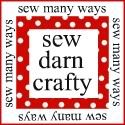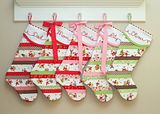I am currently working on a little bishop and have chosen to put Swiss edging on the sleeves. Many people use a machine roll and whip technique to accomplish this. I prefer a different method. I originally found this method on some little vintage garments.
First, I starch and press my trim and sleeve edge. My iron and can of spray starch are often my best friends! Next, I place the trim and sleeve right sides together. I have determined exactly where I wish for my trim to be placed, in order to obtain the correct width of finished sleeve ruffle. You can tell this is a bishop sleeve, already pleated with several half-space rows and then flattened. This is why you need to use long threads when pleating those sleeves!
I use my Edge Joining foot, and stitch right next to the decorative part of the Swiss edging. I decreased the straight stitch to about 2.0, on my machine.
Next, I will turn it over to the wrong side and trim both seam allowances. I trim the fashion fabric to about 1/8". I trim the batiste of the Swiss edging so that it is about 1/8" more than the fashion fabric.
Now it is back to our friend the Iron! I first press my stitching flat -- which I forgot to take a photograph! This helps to sink those stitches into your fabrics and make everything smooth.
I will use the tip of the iron and the edge of the sole plate to gentle press the fashion fabric away from the Swiss edging, making sure that everything is neat and flat.
This is what it now looks like on the wrong side of the sleeve.
If you look closely, you can see that the batiste of the Swiss edging is wider than the seam allowance of the sleeve edge. In other words, it is almost twice as wide. I will now tuck that portion of the batiste underneath, forming a smooth and finished edge. Since the Swiss edging is made from a fine 100% cotton, it is very easy to simply finger press this into place.
With needle and thread, I slipstitch it in place, just like I would a hem.
This is what it looks like on the right side when finished.
I have seen this method used on various garments, and other places besides sleeve edges. It could also be used to attach entredeux, which is then finished with a lace edging.
Yes, this method probably takes a little bit longer than using a machine roll and whip. However, I find that it is a little less bulky with some fabrics. I believe it also gives a more finished and softer appearance. I am using fine fabric and trims, and hoping to make garments that will last a long time. A few extra minutes definitely seem worthy! There is also something very soothing about taking needle and thread and hand finishing all the little details that make our garments so special.Here are a couple of other sweet little bishop sleeves . . .
finished with Swiss edging and this same technique.
Now, I have to get hopping on completing the smocking and construction of this little bishop. It needs to be ready before Mr. Easter Bunny arrives with the eggs!







































11 comments:
Very pretty!! Thanks for sharing.
I really like that finish, I'm a bit roll & whip challenged this is a much nicer alternative. Now to just remember it the next time it's needed.
I like it. I have fallen in love with a similar technique for doing entredeux, I hadn't thought to transfer that to eyelet edging. Beautiful.
I love that finish... Can't wait to see the bunny dress!
I love that finish too!! ( and I really love that little edging)
You do a great job on a tute!!!
Thank you!
Martha, would love to learn more about your technique with entredeux. One of my little vintage dresses has a slightly different method with entredeux. Wonder if it is the same?
I use the method Jeannie calls "old fashioned method of attaching entredeux." The only difference is that she stitches down the turn under seam allowance with a running stitch. Jeannie's post today shows the entredeux at the neck with the running stitch hem.
http://oldfashionedbaby.blogspot.com/2010/03/i-love-to-smock.html
I will try that next time. I love how it looks and I had never saw that done before now. Thanks for sharing:)
Love your blog, and thanks for this great information. I'm still learning about heirloom sewing and this is just the kind of detail I can use.
Hello, I already tried it and it came out quite nice. The daygown's bottom looks much better with this finish.
I'm interested in a new technique for neck bindings - any thoughts?
Lynette, I am so glad you liked this technique, and even happier that you have already tried it!
Let me think on that neck binding. I am still smocking on my little bishop!
Post a Comment